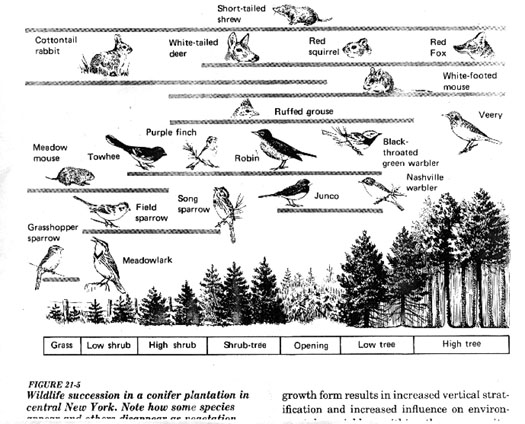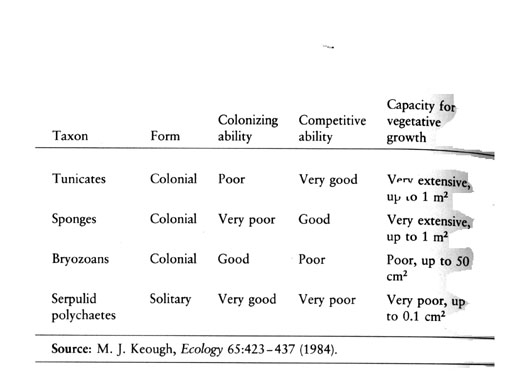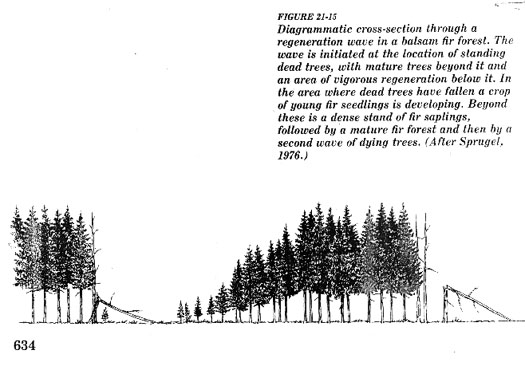
Succession & Biomes
I. Communities change over time.
A. Disturbances cause change.
1. Primary succession occurs when disturbance disrupts the structure of the soil so that initially no organisms are living in the area. Ex. Lake Michigan sand dunes.

2. Secondary succession occurs when a disturbance disrupts the community but the soil structure remains intact. (Ex. agricultural disturbance)

B. The nature of a disturbance affects community response.
1. Intensity: consider the effects of an ice storm vs. a glacier.
2. Scale
a. Spatial (woodchuck and glaciers both cause soil disturbance)
b. Temporal (forest regeneration immediately after harvesting vs regeneration after use as a pasture).
3. Predictability. (Frost in Maryland vs Florida)--fire in deciduous forest vs fire adapted forests
4. Stability of communitiy
a. Resistance--resist disturbance.
b. Resiliance--response rate after disturbance.
C. Patterns of succession are driven by dispersal and competition.
a. Facilitation emphasizes the view that succession is a developmental sequence in which each stage paves the way for the next. In the early stages, colonizing species may facilitate the development of later stages by contributing to the nutrient and water levels of soil and by modifying the microenvironment of the soil surface. Alder trees which harbor nitrogen fixing bacteria in their roots provide an important source of nitrogen to soils developing on sand bars in rivers and in areas exposed by retreating glaciers. Black locust plays the same role in early succession in the southern Appalachian region.
b. Inhibition is also in integral part of succession. One species may inhibit another through predation, or competition. Species that invade later in succession inhibit species that specialize at earlier stages of success. The course of succession may sometimes depend on precendence (Ex. Black oaks inhibit colonization by beech on Lake Michigan sand dunes, Australian reef colonization).

c. Tolerance suggests that species can invade newly exposed habitat and become established with equal ease, but that succession is determined by the life spans and competitive abilities of the colonists. Early stages will be dominanted by individuals that become established quickly but may be are not necessarily good competitors. Better competitors may grow and reproduce more slowly and therefore take longer before they become a dominant player in the community.

b. Rate of successions determined by climate, nutrients, predation, colonization.
D. Succession may or may not reach an equilibrium (a climax community). Many communities are in a constant process of succession since disturbance is a predictable feature of the environment. (Ex. Drought/fire, grazing)

II. Succession results in a variety of endpoints. Biomes are large scale communities with characteristic vegetation and animal life. Whitaker classified terrestrial biomes on the basis of climate and moisture availability.
A. Tundra characterized by presence of permafrost. Liquid water availabe only a short time of the year. Vegetation and trees low and small. Occurs at high latitudes but also at high elevations.
B. Taiga or northern boreal forests form a broad belt south of tundra biome. Winter dormancy occurs in both plants and animal (hibernation). Vegetation mostly evergreen, coniferous trees and 1-2 species dominant large tracts of land.
C. Temperate forests range from broadleafed deciduous forests to evergreen forests of Florida. Species diversity lower than in tropics.
D. Tropical rainforests cover 7% of earth's surface but have 50% of all species. Rainfall is typically more than 200 cm per year. Forests can have incredible tree diversity with the record being 269 species in a 1hectare (100m x 100m) area in a Peruvian rainforest.
E. Grasslands include temperate zone prairies as well as tropical grasslands known as savannahs which also have widely spaced trees, such as the baobob. Large grazing herbivores are an integral part of the community.
F. Deserts are characterized by low and unpredictable rainfall, often less than 25 cm/year. Annual plants may time growth and reproduction when rain occurs. Other plants such as cacti store water, and other plant have deep roots that reach groundwater. Deserts may also be cold.
G. Terrestrial bias but also marine and freshwater communities. Affected by depth, pH, curents.